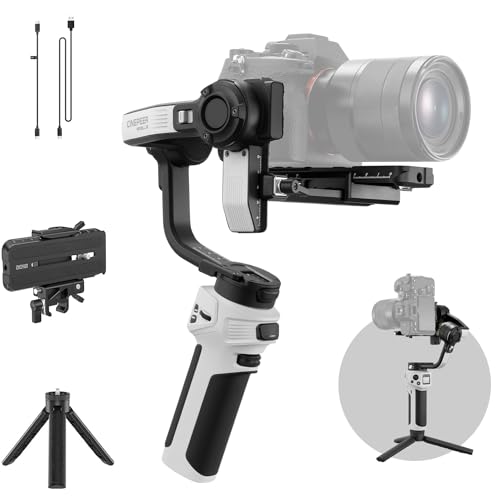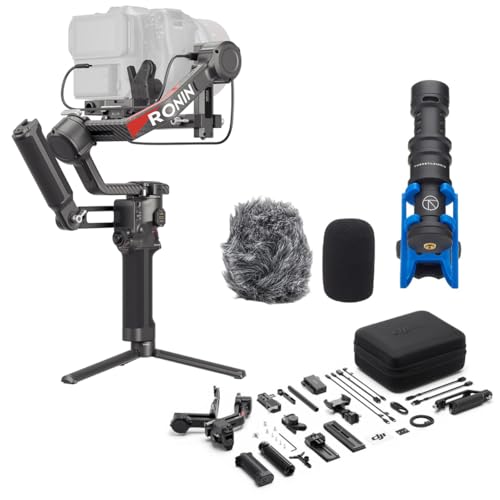Introduction to Gimbals and Steadicams
In the realm of filmmaking and video production, achieving smooth, stable shots is paramount. Two prominent stabilization systems that assist in this endeavor are gimbals and steadicams. Understanding the fundamental principles of these devices is crucial for selecting the appropriate tool for specific filming needs.
A gimbal is an electronic stabilization device that employs motors and sensors to balance a camera on multiple axes, typically three: roll, pitch, and yaw. This technology counteracts unwanted movements and vibrations, allowing the operator to capture smooth footage even while in motion. Popular gimbals like the DJI RS 4 Pro, Zhiyun Weebill 3S, Moza Aircross 3, and DJI Osmo Mobile 6 exemplify the latest advancements in this field, offering features such as app integration, extended battery life, and advanced follow modes that cater to the evolving demands of filmmakers.
On the other hand, a steadicam operates on mechanical principles rather than electronic ones. It uses a system of counterweights to achieve balance and isolate the camera from the operator’s movements. The steadicam allows for significant freedom of motion, enabling the operator to navigate through dynamic environments while maintaining stability. Key models in this category include the Steadicam Aero 30, Glidecam HD-Pro, Flycam Redking, and Steadicam Volt, each with its unique design and features tailored to various filming scenarios.
Both gimbals and steadicams offer distinct advantages and disadvantages that influence their usability in filmmaking. Through the exploration of these stabilization systems, we can better understand their operational mechanics and the scenarios in which each excels, thus providing a comprehensive comparison for aspiring videographers and filmmakers.
Key Features of Gimbals
Gimbals have revolutionized the way filmmakers and content creators approach stabilization, largely through their electronic stabilization capabilities. Unlike traditional stabilizers, gimbals employ advanced sensors and motors that adjust to camera movements in real time, ensuring smooth footage even during dynamic action or movement. This feature is particularly advantageous for capturing steady shots while walking or running, making them a popular choice for documentary filmmakers, vloggers, or anyone requiring mobility.
One of the standout advantages of gimbals is their versatility. Many gimbal models are designed to accommodate a range of camera sizes and types, from smartphones to DSLRs and mirrorless systems. This flexibility allows users to switch between different setups swiftly, enhancing productivity during shoots. Moreover, several gimbals are equipped with various shooting modes, including panning mode, follow mode, and lock mode, giving users ample creative control over their framing and composition. The intuitive controls found on many gimbal devices further facilitate ease of use, allowing even novice users to achieve professional-looking results with minimal effort.
When examining specific gimbal models, it is essential to consider their performance and ideal use cases. For instance, the DJI Ronin-S is notable for its robust payload capacity, making it suitable for larger cameras and extensive rig setups. Conversely, the Zhiyun Crane-M2 is designed with portability in mind, appealing to travel filmmakers who prioritize light equipment. Each model shines in differing scenarios, underscoring the importance of selecting the right gimbal based on the project’s specific requirements. Ultimately, understanding the distinct features of gimbals equips filmmakers with the tools to elevate their work and achieve captivating visuals.
Key Features of Steadicams
Steadicams have long been a staple in the world of cinematography, distinguished by their unique mechanical stabilization system that offers a distinct approach to achieving smooth footage. One of the primary advantages of using a steadicam is its durability; the design often incorporates robust materials, allowing it to withstand the rigors of various filming conditions. This reliability is particularly evident when navigating challenging terrains or capturing dynamic action sequences, where a steadicam excels in maintaining stability without the need for electronic assistance.
Another noteworthy characteristic of steadicams is their ability to deliver a traditional cinematic feel. This quality is highly regarded by filmmakers who favor a more organic and fluid movement reminiscent of classic cinema. Unlike gimbals, which rely heavily on electronic motors and batteries, steadicams allow for a more intuitive handling experience, giving the operator greater control over the camera’s movements. The seamless gliding effect achieved through this mechanical system is often favored for narrative filmmaking, where emotional engagement plays a crucial role.
Specific models, such as the Glidecam and the Steadicam trademark products, are known for their exceptional build quality. These devices have been meticulously engineered to provide superior performance in various filming environments. For instance, while shooting in bustling urban settings or during high-speed events, a steadicam can outperform a gimbal due to its ability to absorb shock and maintain frame integrity despite rapid motions. This impressive stabilization capability means that the footage remains fluid, allowing for captivating storytelling without distracting shakes or jitters.
In terms of typical scenarios, steadicams are often preferred in situations where creative camera movements are essential, such as in wedding films, documentaries, and narrative features. By offering filmmakers versatile solutions for smooth and engaging shots, steadicams continue to hold a prominent position in modern cinematography.
Choosing the Right Stabilization System for Your Needs
When faced with the decision between a gimbal and a steadicam, various factors must be taken into account to select the most suitable stabilization system for your specific project requirements. One primary consideration is the type of shooting you plan to undertake. Gimbals are often favored for dynamic shots, where smooth, rapid camera movements are integral to the storytelling process. They excel in fast-paced environments, such as action scenes or events, where mobility and balance are crucial. In contrast, steadicams tend to shine in scenarios demanding a more controlled, fluid motion, particularly when shooting longer takes.
Budget also plays a significant role in the decision-making process. Generally, gimbals are available at a wide range of price points, making them accessible for both amateur filmmakers and professionals. In contrast, steadicams can represent a more considerable investment, as they often require specialized rigs and training to operate effectively. Understanding your budgetary constraints is, therefore, essential when evaluating your options in the realm of stabilization systems.
Personal preferences and comfort with each system should not be overlooked. Many users report that operating a steadicam offers a more intuitive experience, while others prefer the technology-driven ease of a gimbal. Expert opinions highlight the importance of handling both systems before making a final choice; doing so will help you assess which feels more natural and aligns best with your shooting style.
Real-life testimonials from experienced users of both gimbals and steadicams can further inform your decision. Filmmakers often share insights about how each system influences the creative process and enhances the final product. Ultimately, the ideal stabilization system will be a reflection of your individual filming needs, project specifications, and personal comfort, ensuring that you achieve the desired results.






